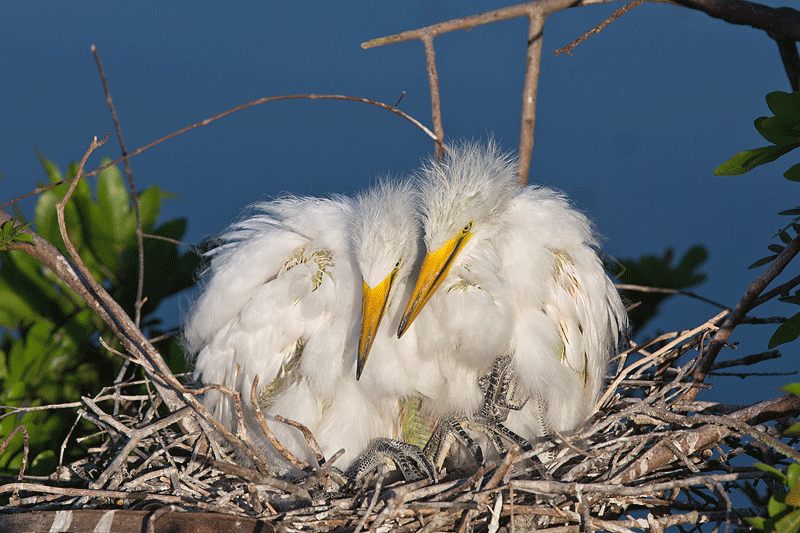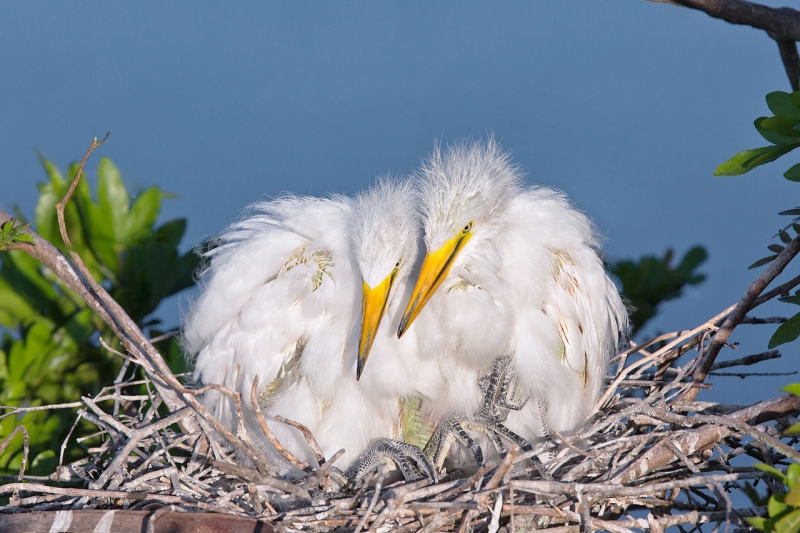|
This image was created with the hand held Canon 70-200mm f/2.8L IS II lens, the 2XIII teleconverter (hand held at 400mm), and the Canon EOS-5D Mark III. ISO 200. Thought that I was at ISO 400….: 1/400 sec. at f/11 in Manual mode. AI Servo Rear Focus AF active at the moment of exposure. Click here if you missed the Rear Focus Tutorial. Be sure to click on the image to see the spectacular larger version. |
Is the EOS-5D Mark III–2X III Teleconverter–70-200f/2.8L IS II a Viable Combination?
In a word. Yes. The combination is incredibly sharp. In addition, I tried it a bit for flight photography with somewhat mixed results in very difficult conditions; there were no hangers. I am not sure how I got to ISO 200 but I love the end result above. See the animated GIF below for image clean-up details. NIK Color Efex Pro Tonal Contrast at 30% and White Neutralizer at 60%.

|
Image clean-up involved a combination of Clone Stamp Tool and Patch Tool work to execute the Divide and Conquer strategy and a series of flopped and warped Quick Masks that were fine tuned with Layer Masks. All as described in detail in Digital Basics and Robert’s O’Toole’s APTATS I (Quick Masks) and APTATS II (Layer Masks). I first lightened the image during ACR conversion and then again using the Curves filter in NIK Color Efex Pro. As soon as I saw the shade of blue water I knew that White Neutralizer would make it sing.
As regular readers know NIK’s Color Efex Pro 4 is now an integral part of my workflow. Click here for an excellent NIK Color Efex Pro Tutorial. And remember, you can save 15% on all NIK products by clicking here and entering BAA in the Promo Code box at check-out. Then hit Apply to see your savings. You can download a trial copy that will work for 15 days and allow you to create full sized images.
Contest Update
The BIRDS AS ART 1st International Bird Photography Competition has been going great guns. Additional folks are getting in on the fun each day. And many folks who had previously finished their entries have been taking advantage of the extension by uploading even stronger images. Thanks to those who responded to my Hand of Man pleas; it is now one of our strongest categories. While each of the following categories has some very strong images there is still room for improvement: Small in the Frame/Environmental, Pleasing Blurs, Youth, and especially Captive (photographs of captive, zoo, pet, or rehab birds).
Those of you who have been in the dark can learn more about the BIRDS AS ART 1st International Bird Photography Competition here or by visiting the main contest page here.
Important Contest News
While you may upload images until 11:59pm eastern time on April 30, 2012, the very last day for registering for the contest and for making eligible B&H purchases will be Monday, April 23, 2012. This will give us time to process your registrations and verify your B&H purchases and will give you time to upload your images successfully. Good luck to all.
Do save your e-mail receipts for eligible B&H purchases made after Monday, April 23 as you will be able to use them for entry into the BIRDS AS ART 2nd International Bird Photography Competition; details will be announced in several months. Please remember, only B&H purchases made using the product-specific BAA B&H affiliate links in the Bulletins or on the blog or the more general link here qualify. See additional details by scrolling down to item 2 here. If in doubt, simply start your B&H searches by clicking here:
http://www.bhphotovideo.com/?BI=6633&KBID=7226
Earn Free Contest Entries and Support both the Bulletins and the Blog by making all your B & H purchases here.
More and more folks are earning multiple contest entries with their B & H purchases. See here for details on that. Eleven great categories, 34 winning and honored images, and prize pools valued in excess of $20,000. Click here to visit the competition home page.
Shopper’s Guide
Below is a list of the gear used to create the images in today’s post. Thanks a stack to all who have used the Shopper’s Guide links to purchase their gear as a thank you for all the free information that we bring you on the Blog and in the Bulletins. Before you purchase anything be sure to check out the advice in our Shopper’s Guide.
Canon 70-200mm f/2.8L IS II lens. Man, I am loving this lens on my shoulder with the 2XIII teleconverter. I also use it a lot–depending on the situation–with the 1.4X III TC.
Canon EOS-5D Mark III. Man, I am in love with this camera body. Both the files and the AF system are superb. I cannot wait to get to Morro Bay.
And from the BAA On-line Store:
The Lens Align Mark II. I use the Lens Align Mark II pretty much religiously to micro-adjust all of my gear an average of once a month and always before a major trip. Enjoy our free comprehensive tutorial here.
BreezeBrowser. I do not see how any digital photographer can exist without this program.















in the original it looks like a little dust on the sensor you can see in the blue sky? I prefer the contrast in the unedited version but like how you have edited out of the extra twigs.
The big spots in the original were likely o-of bugs. I pretty much agree with you on the contrast and the WHITEs; maybe just a bit brighter than in the ORIG would be best.
As for the extra twigs, their removal involved many steps, too many to post here. As it says above, image clean-up involved a combination of Clone Stamp Tool and Patch Tool work to execute the Divide and Conquer strategy and a series of flopped and warped Quick Masks that were fine tuned with Layer Masks. All as described in detail in Digital Basics and APTATS I (Quick Masks) and APTATS II (Layer Masks).
Their is a wealth of additional info on both CDs.
Just a heads up on the 5D3, Canon has announced a light leak issue so it may be wise to hold off buying one until they fix this. It only causes a minor problem and only in low light so most users won’t notice it. See Canon website for details.
I just edited a cattle egret using the Nik program with your recipe and it came out great. BTW, I am routinly running Nik Dfine in auto mode on all my high ISO birds in flight images now. It is quite effective at smoothing the sky while maintaining detail in the birds. Sometimes I do mask the bird though. It is rarely really necessary but only takes a few seconds using Color Select. I then invert that mask and apply it to my sharpening layers to avoid sharpening the sky. Kill two birds with one mask sort of thing. ;-0
The clean up works well. But I think the large ‘double T’ twig is very funny, like a natural sissy bar on the back of the young Egrets easy rider nest!
Nice timing. I just got back from Dot-Dash (I know you know what I am talking about!) and have a lot of egret shots that should benefit from your recipe. I was shooting with my 70-200 and 2x (both new versions) on my 1D4 and there was some surprise from the fellow I was with that it is so sharp. HUGE improvement over the old 2x.
Great optimized image..Love it.The water color is perfection!! Going out right now and try the 2X on my 70-200. Blue skies today:)
I think the nest in the optimized version looks “flashed”. I would leave the original light on the nest and keep the optimized chicks & sky. That said the 70-200 & 2X looks like a great combo!
Thanks Charles. I think that the TCs would prove to be sharp on a tripod and good technique even in low light/higher (to a limit of course) ISO situations. But sun increases contrast and that does allow for more accurate focusing.
Good point Artie – it is easier for both human and AF to focus in high contrast situations.
Actually I prefer the original shot with the branches behind. The cleaned-up version seems a little sterile to me, also the chicks look kind of “flat”. But I guess this is a matter of taste.
Ruthie
I figured that there would be a few who liked the branches and I am fine with that. As far as the WHITEs, they are way greyed out in the original and in the optimized image they have lots of detail.
Great shot. I constantly toy with the idea of moving to this type of combo over my beloved 100-400 which is my current birding lens until my 600 f/4 IS mkII is available. I know you switched from the 100-400. I don’t own any of the 70-200 zooms and would love to own the 2.8IS mk2 but the 100-400 just seems easier to use without dealing with teleconverters. Maybe once I get the 600 it will make more sense to give up the 100-400. Did you ever regret switching away from the 100-400?
Thanks Geoff. That quite a jump up from the 1-4 to the 600 II! Yes, the 100-400 is very versatile but I do not mind switching TCs (or removing one when I need to get to 70mm for a bird-scape) and I love the increased sharpness that comes with the 70-200 f/2.8 L IS II and the Series III TCs.
If you decide to bite the bullet please e-mail for our B&H links. Thanks!
ps: Have never regretted selling the 100-400, not for a second.
I like the colors in this one – very captivating!
Once again you prove that under the right conditions and with the proper technique, the 2X produces sharp images. I’ve found that all of Canon’s TCs function best in bright light. The higher the ISO the worse they perform.
You also continue to tempt me toward picking up a 5D3 sooner rather than later 🙂